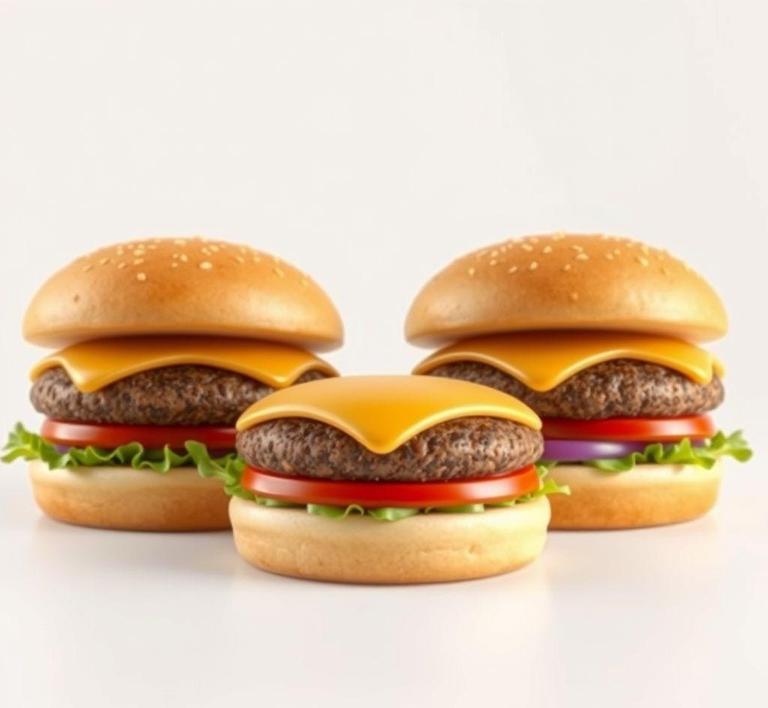Have you ever bought too many hamburger buns and wondered if you can freeze them for later? Well, good news! Refreezing hamburger buns is a great way to keep them fresh for an extended period. Whether you’ve overstocked for a barbecue or want to store some extras, refreezing can help maintain their texture and flavor if done correctly. In this guide, we’ll walk you through the steps to properly refreeze hamburger buns, so you can enjoy them just as fresh as the first time you opened the package. Let’s dive into the best practices for freezing and refreezing those soft, fluffy buns!
Can You Refreeze Hamburger Buns?

The short answer: Yes, you can refreeze hamburger buns, but there are important considerations to keep in mind before doing so. Bread products like hamburger buns contain moisture, which makes them susceptible to changes in texture and quality when frozen and thawed multiple times.
Refreezing is generally safe if the buns have been handled properly and have not been left out at room temperature for extended periods. When you thaw hamburger buns, the moisture inside can cause them to become slightly soggy or develop condensation. If you refreeze them immediately after thawing-especially if any moisture has accumulated-it can lead to ice crystals forming inside the bread, which ultimately causes a crumbly or stale texture once thawed again.
From a food safety perspective, if buns have been kept refrigerated or frozen below 0°F (-18°C) continuously, refreezing poses no risk of bacterial growth. However, if they were left out too long or exposed to warm temperatures, the risk of mold or bacterial contamination increases, making refreezing unsafe.
In summary, while refreezing hamburger buns is possible, the primary concern lies in how this impacts the bun’s quality rather than safety-provided basic food safety principles are followed.
How To Refreeze Hamburger Buns?
Refreezing hamburger buns isn’t just about tossing them back in the freezer. To maintain the best possible texture and flavor, follow these steps:
1. Assess The Condition Of The Buns Before Refreezing
Before deciding to refreeze, inspect the buns carefully:
- Are they free of mold or any off-putting odors?
- Have they been thawed for less than a day?
- Are they still somewhat firm and not overly soggy?
If the buns pass this check, proceed with refreezing.
2. Properly Wrap The Buns
To prevent freezer burn (which dries out bread and makes it stale), wrap the buns tightly. Use plastic wrap or aluminum foil to create a sealed barrier. Then, place the wrapped buns in a resealable freezer bag or an airtight container for extra protection.
3. Remove Excess Air
Before sealing the bag, squeeze out as much air as possible. Air trapped inside the packaging causes freezer burn and impacts flavor and texture negatively.
4. Freeze Quickly
Place the wrapped buns in the coldest part of your freezer to freeze them rapidly. Quick freezing helps minimize the formation of large ice crystals that can degrade the bun’s structure.
5. Label And Date
Mark the package with the date of refreezing to keep track of storage time. Hamburger buns can generally be stored for up to 3 months in the freezer without significant loss of quality.
6. Thawing Tips For Refrozen Buns
When you’re ready to use the buns again, thaw them slowly at room temperature while still wrapped to help retain moisture. If you prefer a quicker method, wrap the buns in a slightly damp paper towel and microwave in short bursts for a soft, warm bun.
Quality Impact
Refreezing hamburger buns invariably affects their texture and taste, but understanding these changes helps set realistic expectations:
Texture Changes
- Moisture loss: Each freeze-thaw cycle causes water molecules in the bread to crystallize and disrupt the gluten network. This often results in buns that feel drier and more crumbly.
- Staleness: Refreezing accelerates the staling process, causing the buns to lose their fresh, soft quality faster than buns frozen just once.
- Crumbly or Tough Crust: The crust might become harder or lose its initial softness due to moisture fluctuations and ice crystal damage.
Flavor Changes
- The flavor usually remains acceptable but can sometimes taste slightly ‘off’ or muted due to moisture loss and oxidation.
- Buns with added preservatives might hold up better flavor-wise than homemade or preservative-free varieties.
Appearance
- Ice crystals may form on the surface or inside the packaging, creating frost. While harmless, frost can indicate moisture migration that affects texture.
- Buns may shrink slightly or develop minor cracks in the crust.
Despite these changes, refrozen buns are still perfectly fine for sandwiches, burgers, or toast, especially if you’re not overly picky about ideal bakery-fresh texture.
Refreezing hamburger buns is definitely doable and safe if done carefully, but it comes with a trade-off in quality. The key lies in how the buns are handled at each stage-keeping them properly wrapped, frozen promptly, and not leaving them out for too long before refreezing. While you can save buns from waste this way, expect a drier, slightly crumbly bun that’s best suited for casual meals rather than gourmet presentations.
If you anticipate needing to store buns for extended periods, it’s better to freeze them once in small portions that can be thawed and used all at once. That way, you preserve the fresh, soft texture that makes hamburger buns so enjoyable.
So, next time you find yourself wondering whether to toss or save those leftover buns, now you know how to refreeze them with minimal damage-and keep those burgers delicious!
Is It Safe To Refreeze Hamburger Buns?
When it comes to refreezing hamburger buns, the answer depends on how the buns were handled before refreezing. Generally, refreezing hamburger buns is safe as long as they were properly stored and have not been left out at room temperature for extended periods. Bread, including hamburger buns, is a relatively stable product because of its low moisture content compared to other perishable foods, making it less susceptible to rapid bacterial growth.
However, safety isn’t the only factor to consider. Refreezing bread can impact its texture and taste, sometimes leading to dryness or freezer burn, which affects the overall eating experience. If the buns were thawed in the refrigerator and kept cold throughout, then refreezing them won’t introduce significant health risks. On the other hand, buns left out on the counter for hours or partially thawed and then left unrefrigerated can harbor mold or bacteria, making refreezing unsafe.
Signs That Hamburger Buns Should Not Be Refrozen
Identifying when buns should be discarded rather than refrozen is crucial for safety and quality:
- Visible Mold: This is the clearest sign that buns should be tossed out. Mold spores can spread beyond visible spots, and refreezing won’t kill mold.
- Off Smell or Taste: If the buns smell sour, musty, or otherwise unpleasant, it indicates spoilage.
- Texture Changes: Excessive moisture or sliminess can mean the buns are deteriorating, often due to improper storage.
- Extended Time at Room Temperature: If buns have been out for more than 2 hours (or 1 hour in hot climates), refreezing is unsafe.
- Freezer Burn: While freezer burn is not dangerous, if buns are heavily freezer burned, their quality suffers, and refreezing might make it worse.
Common Refreezing Mistakes
Refreezing bread might sound straightforward, but people often make avoidable mistakes that reduce bread quality or safety:
- Refreezing after Prolonged Room Temperature Exposure: Leaving buns out too long before refreezing invites bacteria and mold growth.
- Not Wrapping Properly: Air exposure causes freezer burn and dryness. Using plastic wrap, foil, or airtight containers is essential.
- Repeated Thawing and Refreezing Cycles: Each cycle degrades bread texture, causing crumbly or stale buns.
- Refreezing Contaminated Buns: If buns are exposed to raw meat juices or other contaminants, refreezing does not eliminate pathogens.
- Ignoring Freezer Temperature: Fluctuating freezer temps can cause partial thawing and refreezing, which degrades bread quality.
Tips And Tricks
To make the most of refreezing hamburger buns while maintaining safety and quality, consider these tips:
- Freeze Immediately After Purchase or Thawing: The fresher the bun before freezing, the better the taste later.
- Portion Control: Freeze buns in small batches or individually so you only thaw what you need.
- Use Airtight Packaging: Double-wrap buns in plastic wrap and place them in freezer bags with the air squeezed out to prevent freezer burn.
- Label and Date: Always mark buns with the freeze date to avoid keeping them too long. Ideally, consume within 3 months.
- Thaw Properly: Thaw buns in the fridge overnight or gently at room temperature. Avoid microwaving directly as it can toughen the crust.
- Refresh After Thawing: To restore softness, warm buns briefly in an oven or toaster oven.
Conclusion
Refreezing hamburger buns is generally safe when done correctly, with key considerations for food safety and quality. The bread’s low moisture content offers a natural advantage, but improper handling-especially leaving buns out too long or failing to protect them from air exposure-can lead to spoilage or a less-than-pleasant eating experience. By paying close attention to signs of spoilage, avoiding common pitfalls, and using smart freezing techniques, you can keep your buns fresh, tasty, and safe even after refreezing. So next time you have extra buns on hand, don’t hesitate to freeze and refreeze them-just do it thoughtfully to enjoy delicious burgers every time!


